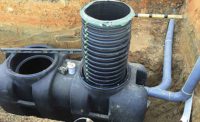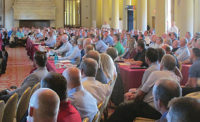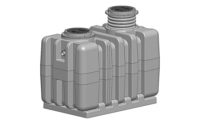Charles Tevis has been in the grease-interceptor business for more than 25 years and this is the hottest the market has been in his career.
“In the 1990s when you talked about grease interceptors, one had to do a lot of promoting,” says Tevis, a division manager of grease interceptors at Stoystown, Pa.-based Highland Tank. “In the last couple years regulations to prevent sanitary sewer overflows and all-around increased awareness have resulted in a greater demand.”
And manufacturers of grease interceptors continue to turn things up a notch in the innovation realm to help best meet the needs of their customers.
Chicago-based MIFAB recently released injection- and rotational-molded high-density polyethylene (HDPE) grease and oil interceptors up to 100 gpm with a lifetime warranty.
“These complement our traditional steel and stainless steel interceptor product range,” MIFAB President Michael Whiteside says. “We have received a patent for our unique and labor-saving lid-extension design.”
During the design of a new or updated grease interceptor at MIFAB, working with specifying engineers, building owners and others is important.
“The primary goal is to introduce a design with features our customers have asked us for,” Whiteside says. “The more we can incorporate requested design features, the more accepted and successful the product will be.”
Zurn Green Turtle’s latest product is its 250-gal. FOG-ceptor, a fiberglass hydromechanical unit with a dual manway design and an external flow-control device. Zurn Green Turtle developed FOG-ceptor as a compact unit that can be installed in multiple areas and decrease pumping frequency.
“It is designed to bridge the gap between the inside of the kitchen hydromechanical interceptor and the outdoor, buried-in-the-ground gravity interceptors,” Zurn Green Turtle Marketing and Engineering Manager Silvano Ferrazzo says.
Canplas Business-Development Manager Andrew Bird notes the Canada-based company recently expanded its hydro-mechanical interceptor line with an eye toward easier upkeep and installation.
“The key to these products is accessibility for maintenance,” he says. “These units have a clamshell design with a simple push-pull action to activate it. It allows the flow control to be integrated into the unit and is accessible for cleaning.”
Growing markets
The traditional markets — such as hospitality, restaurants, and large health-care facilities — remain strong for grease interceptors. But MIFAB sees a burgeoning market for the company’s HPDE units.
“We see a growing interest from municipal water-treatment authorities in HDPE units,” Whiteside says. “That’s because of the problems with concrete interceptors cracking and leeching contaminants into the surrounding environment. We are spending more time making this market group aware of the advantages of HDPE grease and oil interceptors vs. concrete.”
Bird says key stakeholders in the grease interceptor market include jurisdictions, engineers/specifiers, architects and owners/operators.
“All the markets that have been there are still there, but the market is like an onion. You keep peeling back layers to the marketplace. The education and the price of development are extremely important.”
Where the road leads
MIFAB is a member of the Plumbing & Drainage Institute and will attend code meetings to educate various code bodies on the advantages of requiring the use of PDI-approved grease interceptors. The way the code community evolves and adopts HDPE units will show a changing landscape, Whiteside says.
“We see a growing shift away from concrete grease interceptors and toward HDPE units,” he says. “This process will slowly evolve as more codes state the need for HDPE grease interceptors.”
Bird agrees concrete might be fading away and other materials will fill the void. “You’ll continue to see the preference for metals and concrete be errored with high-performance materials — be it plastic or fiberglass,” he says.
Bird says Canplas is looking at a number of technologies and enhancements to its line that may soon be coming to the market. This includes the possibility of a more streamlined approach regarding water in the removal of containments.
“You’ll start to see grease-management services move away from having a body of water that needs to separate the FOG and allow that process to be done from a transitional flow of water,” he explains.
Ferrazzo adds enhanced automatic grease interceptors have a big future. As land becomes more costly and developers build upward instead of outward, the need for a FOG-removal device that can easily work on the 30th floor of a mixed-use complex is critical.
“Something that can dump the grease collected into a bucket or removed another way —there is a great demand for that,” he says. “You’re seeing a lot of commercial kitchens that are not on the main floor, which is historically where grease interceptors are installed. There is a need for something low-maintenance and that does not need to be pumped out from a long distance.”
This article was originally titled “FOG continues to crawl in” in the September 2017 print edition of Supply House Times.






